Potential of Waste Marble Sludge for Repressing Alkali-Silica Reaction in Concrete with Reactive Aggregates
Abstract
:1. Introduction
2. Material and Mortar Mix Proportions
3. Experimental Procedures
4. Results and Discussion
4.1. Raw Material Properties
4.2. Effect of MS on Mechanical Performance of Mixtures
4.3. Expansion Due to ASR
4.4. Impact of ASR on Mechanical Performance
4.5. Thermal Analysis
4.6. Micro-Structural Analysis
5. Conclusions
- The incorporation of MS at various dosages exhibits a plateau effect. The compressive strength of the specimen increases with the increased replacement of aggregate with MS. However, this trend continues up to 25% MS content. As per the results, 28 days’ compressive strength was observed to be 29 MPa, 42 MPa, and 26 MPa for specimens incorporating 0%, 20%, and 40% MS, respectively. Maximum strength was observed on the incorporation of 20% MS which was 46% more than the control specimen. At 150 days of curing age, the compressive strength was observed to be 42 MPa, 53 MPa, and 30 MPa for specimens incorporating 0%, 20%, and 40% MS, respectively.
- The incorporation of MS caused an increase in the flexural strength up to 15% MS content. On increasing the MS content beyond 15%, the flexural strength started reducing. At 28 days, the flexural strength of specimen incorporating 0%, 15%, and 40% MS was observed to be 10 MPa, 11 MPa, and 10.6 MPa, respectively. Similarly, at 150 days of age, the flexural strength of specimen incorporating 0%, 15%, and 40% MS was observed to be 12.7 MPa, 14.0 MPa, and 12.7 MPa, respectively.
- The control specimen exhibited expansion of 0.23% and 0.28% at 14 days and 28 days, respectively, when subjected to ASR curing regime as prescribed in ASTM C1260. It was observed that on incorporating MS, the expansion was reduced. The expansion observed in the case of specimens incorporating 20% MS was 0.13% and 0.18% at 14 days and 20 days respectively, where the latter was found within the ASTM C1260 limits. Moreover, the specimen incorporating 25% MS exhibited 0.09% and 0.17% expansion at 14 days and 28 days, respectively. Both these values were within the limits prescribed by ASTM C120. The reduction in expansion was primarily attributed to the reduced alkali content and consequently reduced content of reactive aggregates.
- A reduction in compressive and flexural strength was observed due to ASR conditions. The compressive strength of the control specimen (without MS) was observed as 4.6% and 12.5% at 28 days and 150 days, respectively. Similarly, the reduction in compressive strength in specimens incorporating 20% MS was observed at 10.8% and 17.8% at 28 days and 150 days respectively. A similar reduction in flexural strength was also observed.
- The severe micro-cracks were observed in the case of the control specimen subjected to ASR conditions. The formation of ASR gel was also observed. However, the specimen incorporating MS did not exhibit any signs of micro-cracking, although the formation of relatively lesser ASR gel was observed during microstructural analysis.
Author Contributions
Funding
Institutional Review Board Statement
Informed Consent Statement
Data Availability Statement
Acknowledgments
Conflicts of Interest
References
- Figueira, R.; Sousa, R.; Coelho, L.; Azenha, M.; de Almeida, J.; Jorge, P.; da Silva, C.J.R. Alkali-silica reaction in concrete: Mechanisms, mitigation and test methods. Constr. Build. Mater. 2019, 222, 903–931. [Google Scholar] [CrossRef]
- Abbas, S.; Sharif, A.; Ahmed, A.; Abbass, W.; Shaukat, S. Prospective of sugarcane bagasse ash for controlling the alkali-silica reaction in concrete incorporating reactive aggregates. Struct. Concr. 2019, 21, 781–793. [Google Scholar] [CrossRef]
- Abbas, S.; Ahmed, A.; Nehdi, M.L.; Saeed, D.; Abbass, W.; Amin, F. Eco-Friendly Mitigation of Alkali-Silica Reaction in Concrete Using Waste Marble Powder. ASCE J. Mater. Civ. Eng. 2020, 32, 04020270. [Google Scholar] [CrossRef]
- Tänzer, R.; Jin, Y.; Stephan, D. Effect of the inherent alkalis of alkali activated slag on the risk of alkali silica reaction. Cem. Concr. Res. 2017, 98, 82–90. [Google Scholar] [CrossRef]
- Broekmans, M.A. Deleterious reactions of aggregate with alkalis in concrete. Rev. Mineral. Geochem. 2012, 74, 279–364. [Google Scholar] [CrossRef]
- Blanco-Varela, M.; Martinez-Ramirez, S.; Vázquez, T.; Sanchez-Moral, S. Role of alkalis of aggregate origin in the deterioration of CAC concrete. Cem. Concr. Res. 2005, 35, 1698–1704. [Google Scholar] [CrossRef]
- Poyet, S.; Sellier, A.; Capra, B.; Foray, G.; Torrenti, J.M.; Cognon, H.; Bourdarot, E. Chemical modelling of Alkali Silica reaction: Influence of the reactive aggregate size distribution. Mater. Struct. Constr. 2006, 40, 229–239. [Google Scholar] [CrossRef]
- Wright, J.R.; Shafaatian, S.; Rajabipour, F. Reliability of chemical index model in determining fly ash effectiveness against alkali-silica reaction induced by highly reactive glass aggregates. Constr. Build. Mater. 2014, 64, 166–171. [Google Scholar] [CrossRef]
- Ponce, J.M.; Batic, O.R. Different manifestations of the alkali-silica reaction in concrete according to the reaction kinetics of the reactive aggregate. Cem. Concr. Res. 2006, 36, 1148–1156. [Google Scholar] [CrossRef]
- Multon, S.; Toutlemonde, F. Effect of moisture conditions and transfers on alkali silica reaction damaged structures. Cem. Concr. Res. 2010, 40, 924–934. [Google Scholar] [CrossRef]
- Deschenes, R.A.; Giannini, E.; Drimalas, T.; Fournier, B.; Hale, W.M. Effects of moisture, temperature, and freezing and thawing on Alkali-Silica reaction. ACI Mater. J. 2018, 115, 575–584. [Google Scholar] [CrossRef]
- Dehri, I.; Erbil, M. The effect of relative humidity on the atmospheric corrosion of defective organic coating materials: An EIS study with a new approach. Corros. Sci. 2000, 42, 969–978. [Google Scholar] [CrossRef]
- Li, B.; Baingam, L.; Kurumisawa, K.; Nawa, T.; XiaoZhou, L. Micro-mechanical modelling for the prediction of alkali-silica reaction (ASR) expansion: Influence of curing temperature conditions. Constr. Build. Mater. 2018, 164, 554–569. [Google Scholar] [CrossRef]
- Gautam, B.; Panesar, D.K. The effect of elevated conditioning temperature on the ASR expansion, cracking and properties of reactive Spratt aggregate concrete. Constr. Build. Mater. 2017, 140, 310–320. [Google Scholar] [CrossRef]
- Ueda, T.; Kushida, J.; Tsukagoshi, M.; Nanasawa, A. Influence of temperature on electrochemical remedial measures and complex deterioration due to chloride attack and ASR. Constr. Build. Mater. 2014, 67, 81–87. [Google Scholar] [CrossRef]
- Multon, S.; Cyr, M.; Sellier, A.; Diederich, P.; Petit, L. Effects of aggregate size and alkali content on ASR expansion. Cem. Concr. Res. 2010, 40, 508–516. [Google Scholar] [CrossRef] [Green Version]
- Dunant, C.; Scrivener, K. Effects of aggregate size on alkali-silica-reaction induced expansion. Cem. Concr. Res. 2012, 42, 745–751. [Google Scholar] [CrossRef]
- Sanchez, L.; Fournier, B.; Jolin, M.; Bastien, J.; Mitchell, D. Practical use of the Stiffness Damage Test (SDT) for assessing damage in concrete infrastructure affected by alkali-silica reaction. Constr. Build. Mater. 2016, 125, 1178–1188. [Google Scholar] [CrossRef]
- Sanchez, L.; Fournier, B.; Jolin, M.; Bastien, J. Evaluation of the Stiffness Damage Test (SDT) as a tool for assessing damage in concrete due to alkali-silica reaction (ASR): Input parameters and variability of the test responses. Constr. Build. Mater. 2015, 77, 20–32. [Google Scholar] [CrossRef]
- Giannini, E.; Sanchez, L.F.; Tuinukuafe, A.; Folliard, K.J. Characterization of concrete affected by delayed ettringite formation using the stiffness damage test. Constr. Build. Mater. 2018, 162, 253–264. [Google Scholar] [CrossRef]
- Islam, M.S.; Ghafoori, N. A new approach to evaluate alkali-silica reactivity using loss in concrete stiffness. Constr. Build. Mater. 2018, 167, 578–586. [Google Scholar] [CrossRef]
- Stanton, T.E. Expansion of Concrete through Reaction between Cement and Aggregate. Proc. Am. Soc. Civ. Eng. 1942, 107, 54–84. [Google Scholar] [CrossRef]
- Lindgård, J.; Andiç-Çakır, Ö.; Fernandes, I.; Rønning, T.F.; Thomas, M.D.A. Alkali–silica reactions (ASR): Literature review on parameters influencing laboratory performance testing. Cem. Concr. Res. 2012, 42, 223–243. [Google Scholar] [CrossRef] [Green Version]
- Mohammadi, A.; Ghiasvand, E.; Nili, M. Relation between mechanical properties of concrete and alkali-silica reaction (ASR); a review. Constr. Build. Mater. 2020, 258, 119567. [Google Scholar] [CrossRef]
- Helene, P.; Carvalho, M.; Pacheco, J. Engineering field tests for alkali-aggregate reaction. Struct. Concr. 2017, 18, 349–355. [Google Scholar] [CrossRef]
- Munir, M.J.; Qazi, A.U.; Kazmi, S.M.S.; Khitab, A.; Ashiq, S.Z.; Ahmed, I. A literature review on alkali silica reactivity of concrete in Pakistan. Pak. J. Sci. 2016, 68, 53–62. Available online: https://www.researchgate.net/publication/299437103 (accessed on 3 January 2020).
- Jensen, V. Alkali-silica reaction damage to Elgeseter Bridge, Trondheim, Norway: A review of construction, research and repair up to 2003. Mater. Charact. Nov. 2004, 53, 155–170. [Google Scholar] [CrossRef]
- Durand, B.; Veillux, M. Combination of Numerical Modelling and Laboratory Testing to Assess the Alkali-Silica Reaction (asr) Atrapides-des-îles Hydroelectric Power Plant, Québec, Canada. In Proceedings of the 15th International Conference on Alkali-Aggregate Reaction, Sao Paulo, Brazil, 3–7 July 2016. [Google Scholar]
- Swamy, R.N.; Al-Asali, M.M. Engineering properties of concrete affected by alkali-silica reaction. ACI Mater. J. 1998, 85, 367–374. [Google Scholar]
- Marzouk, H.; Langdon, S. The effect of alkali-aggregate reactivity on the mechanical properties of high and normal strength concrete. Cem. Concr. Compos. 2003, 25, 549–556. [Google Scholar] [CrossRef]
- Allard, A.; Bilodeau, S.; Pissot, F.; Fournier, B.; Bastien, J.; Bissonnette, B. Expansive behavior of thick concrete slabs affected by alkali-silica reaction (ASR). Constr. Build. Mater. 2018, 171, 421–436. [Google Scholar] [CrossRef]
- Thomas, M. The effect of supplementary cementing materials on alkali-silica reaction: A review. Cem. Concr. Res. 2011, 41, 1224–1231. [Google Scholar] [CrossRef]
- Al-Akhras, N.M. Performance of olive waste ash concrete exposed to alkali-silica reaction. Struct. Concr. 2012, 13, 221–226. [Google Scholar] [CrossRef]
- Saha, A.K.; Sarker, P.K. Potential alkali silica reaction expansion mitigation of ferronickel slag aggregate by fly ash. Struct. Concr. 2018, 19, 1376–1386. [Google Scholar] [CrossRef] [Green Version]
- Shafaatian, S.M.; Akhavan, A.; Maraghechi, H.; Rajabipour, F. How does fly ash mitigate alkali–silica reaction (ASR) in accelerated mortar bar test (ASTM C1567)? Cem. Concr. Compos. 2013, 37, 143–153. [Google Scholar] [CrossRef]
- Singh, M.; Choudhary, K.; Srivastava, A.; Sangwan, K.S.; Bhunia, D. A study on environmental and economic impacts of using waste marble powder in concrete. J. Build. Eng. 2017, 13, 87–95. [Google Scholar] [CrossRef]
- Akbulut, H.; Gürer, C. Use of aggregates produced from marble quarry waste in asphalt pavements. Build. Environ. 2007, 42, 1921–1930. [Google Scholar] [CrossRef]
- Sata, V.; Jaturapitakkul, C.; Kiattikomol, K. Influence of pozzolan from various by-product materials on mechanical properties of high-strength concrete. Constr. Build. Mater. 2007, 21, 1589–1598. [Google Scholar] [CrossRef]
- Mashaly, O.; El-Kaliouby, B.A.; Shalaby, B.; El-Gohary, A.; Rashwan, M. Effects of marble sludge incorporation on the properties of cement composites and concrete paving blocks. J. Clean. Prod. 2016, 112, 731–741. [Google Scholar] [CrossRef]
- Saboya, F.; Xavier, G.; Alexandre, J. The use of the powder marble by-product to enhance the properties of brick ceramic. Constr. Build. Mater. 2007, 21, 1950–1960. [Google Scholar] [CrossRef]
- Nij, E.T.; Burdorf, A.; Parker, J.; Attfield, M.; Van Duivenbooden, C.; Heederik, D. Radiographic abnormalities among construction workers exposed to quartz containing dust. Occup. Environ. Med. 2003, 60, 410–417. [Google Scholar] [CrossRef]
- Ali, A.; Iqbal, S.; Chaudary, A.U.; Baig, M.N.; Shahzada, K.; Khan, S. The Wastes Utility in Concrete. Int. J. Environ. Res. 2014, 8, 1323–1328. [Google Scholar]
- Steenland, K.; Sanderson, W. Lung Cancer among Industrial Sand Workers Exposed to Crystalline Silica. Am. J. Epidemiol. 2001, 153, 695–703. [Google Scholar] [CrossRef] [PubMed]
- Gholampour, A.; Ozbakkaloglu, T. Performance of sustainable concretes containing very high volume Class-F fly ash and ground granulated blast furnace slag. J. Clean. Prod. 2017, 162, 1407–1417. [Google Scholar] [CrossRef]
- Maheswaran, V.; Chellapandian, J.; Kumar, M. Behavior of GGBS concrete with pond ash as a partial replacement for sand. Adv. Concr. Constr. 2022, 13, 233–242. [Google Scholar] [CrossRef]
- Nadiger, A.; Madhavan, M.K. Influence of Mineral Admixtures and Fibers on Workability and Mechanical Properties of Reactive Powder Concrete. J. Mater. Civ. Eng. 2019, 31, 04018394. [Google Scholar] [CrossRef]
- Abbas, S.; Arshad, U.; Abbass, W.; Nehdi, M.; Ahmed, A. Recycling Untreated Coal Bottom Ash with Added Value for Mitigating Alkali–Silica Reaction in Concrete: A Sustainable Approach. Sustainability 2020, 12, 10631. [Google Scholar] [CrossRef]
- Ahmed, A.; Ameer, S.; Abbas, S.; Abbass, W.; Razzaq, A.; Mohamed, A.M.; Mohamed, A. Effectiveness of Ternary Blend Incorporating Rice Husk Ash, Silica Fume, and Cement in Preparing ASR Resilient Concrete. Materials 2022, 15, 2125. [Google Scholar] [CrossRef]
- Prošek, Z.; Nežerka, V.; Tesárek, P. Enhancing cementitious pastes with waste marble sludge. Constr. Build. Mater. 2020, 255, 119372. [Google Scholar] [CrossRef]
- Xi, Y.; Anastasiou, E.; Karozou, A.; Silvestri, S. Fresh and hardened properties of cement mortars using marble sludge fines and cement sludge fines. Constr. Build. Mater. 2019, 220, 142–148. [Google Scholar] [CrossRef]
- Rodrigues, R.; de Brito, J.; Sardinha, M. Mechanical properties of structural concrete containing very fine aggregates from marble cutting sludge. Constr. Build. Mater. 2015, 77, 349–356. [Google Scholar] [CrossRef]
- Arel, H.Ş. Recyclability of waste marble in concrete production. J. Clean. Prod. 2016, 131, 179–188. [Google Scholar] [CrossRef]
- ASTM C1260-14; Standard Test Method for Potential Alkali Reactivity of Aggregates (Mortar-Bar Method). ASTM: West Conshohocken, PA, USA, 2014; pp. 1–5. [CrossRef]
- ASTM C188/ASTM C188-16; Standard Test Method for Density of Hydraulic Cement. ASTM International: West Conshohocken, PA, USA, 2016 (Reapproved 2003); Volume 95, pp. 1–2.
- ASTM C184; Standard Test Method for Fineness of Hydraulic Cement by Air-Permeability. ASTM: West Conshohocken, PA, USA, 2000; p. 8.
- ASTM. Standard Guide for Petrographic Examination of Aggregates for Concrete 1; ASTM: West Conshohocken, PA, USA, 2015. [Google Scholar] [CrossRef]
- ASTM C114; Standard Test Methods for Chemical Analysis of Hydraulic Cement 1. ASTM: West Conshohocken, PA, USA, 2020; pp. 1–33. [CrossRef]
- ASTM:C29/C29M-09; Standard Test Method for Bulk Density (‘Unit Weight’) and Voids in Aggregate. ASTM: West Conshohocken, PA, USA, 2009; pp. 1–5. [CrossRef]
- ASTM C33/C33M; Standard Specification for Concrete Aggregates. Available online: https://www.astm.org/Standards/C33 (accessed on 27 August 2017).
- Ergün, A. Effects of the usage of diatomite and waste marble powder as partial replacement of cement on the mechanical properties of concrete. Constr. Build. Mater. 2011, 25, 806–812. [Google Scholar] [CrossRef]
- Bonavetti, V.; Donza, H.; Rahhal, V.; Irassar, E. Influence of initial curing on the properties of concrete containing limestone blended cement. Cem. Concr. Res. 2000, 30, 703–708. [Google Scholar] [CrossRef]
- Aliabdo, A.A.; Elmoaty, A.E.M.A.; Auda, E.M. Re-use of waste marble dust in the production of cement and concrete. Constr. Build. Mater. 2014, 50, 28–41. [Google Scholar] [CrossRef]
- Heikal, M.; El-Didamony, H.; Morsy, M. Limestone-filled pozzolanic cement. Cem. Concr. Res. 2000, 30, 1827–1834. [Google Scholar] [CrossRef]
- Meddah, M.S.; Lmbachiya, M.C.; Dhir, R.K. Potential use of binary and composite limestone cements in concrete production. Constr. Build. Mater. 2014, 58, 193–205. [Google Scholar] [CrossRef]
- Nixon, P.J.; Sims, I. RILEM Recommendations for the Prevention of Damage by Alkali-Aggregate Reactions in New Concrete Structures: State-of-the-Art Report of the RILEM Technical Committee 219-ACS; Springer: Berlin, Germany, 2015. [Google Scholar]
- Australian Standard (AS) 1141.60.1; Method for Sampling and Testing Aggregates, Potential Alkali-Silica Reactivity—Accelerated Mortar Bar Method. Australian Press Council: Sydney, Australia, 2014.
- Abbas, S.; Ahmed, A.; Waheed, A.; Abbass, W.; Yousaf, M.; Shaukat, S.; Alabduljabbar, H.; Awad, Y.A. Recycled Untreated Rubber Waste for Controlling the Alkali–Silica Reaction in Concrete. Materials 2022, 15, 3584. [Google Scholar] [CrossRef]
- Afshinnia, K.; Poursaee, A. The potential of ground clay brick to mitigate Alkali–Silica Reaction in mortar prepared with highly reactive aggregate. Constr. Build. Mater. 2015, 95, 164–170. [Google Scholar] [CrossRef]
- Yazici, H. The effect of steel micro-fibers on ASR expansion and mechanical properties of mortars. Constr. Build. Mater. 2012, 30, 607–615. [Google Scholar] [CrossRef]
- Esposito, R.; Anaç, C.; Hendriks, M.A.N.; Çopuroğlu, O. Influence of the Alkali-Silica Reaction on the Mechanical Degradation of Concrete. J. Mater. Civ. Eng. 2016, 28, 04016007. [Google Scholar] [CrossRef] [Green Version]
- Wang, S. Cofired biomass fly ashes in mortar: Reduction of Alkali Silica Reaction (ASR) expansion, pore solution chemistry and the effects on compressive strength. Constr. Build. Mater. 2015, 82, 123–132. [Google Scholar] [CrossRef]
- El-Sayed, H.A.; Farag, A.; Kandeel, A.; Younes, A.A.; Yousef, M.M. Characteristics of the marble processing powder waste at Shaq El-Thoaban industrial area, Egypt, and its suitability for cement manufacture. HBRC J. 2018, 14, 171–179. [Google Scholar] [CrossRef] [Green Version]
- Kabeer, K.S.A.; Vyas, A.K. Utilization of marble powder as fine aggregate in mortar mixes. Constr. Build. Mater. 2018, 165, 321–332. [Google Scholar] [CrossRef]
- Munir, M.J.; Kazmi, S.M.S.; Wu, Y.-F. Efficiency of waste marble powder in controlling alkali–silica reaction of concrete: A sustainable approach. Constr. Build. Mater. 2017, 154, 590–599. [Google Scholar] [CrossRef]

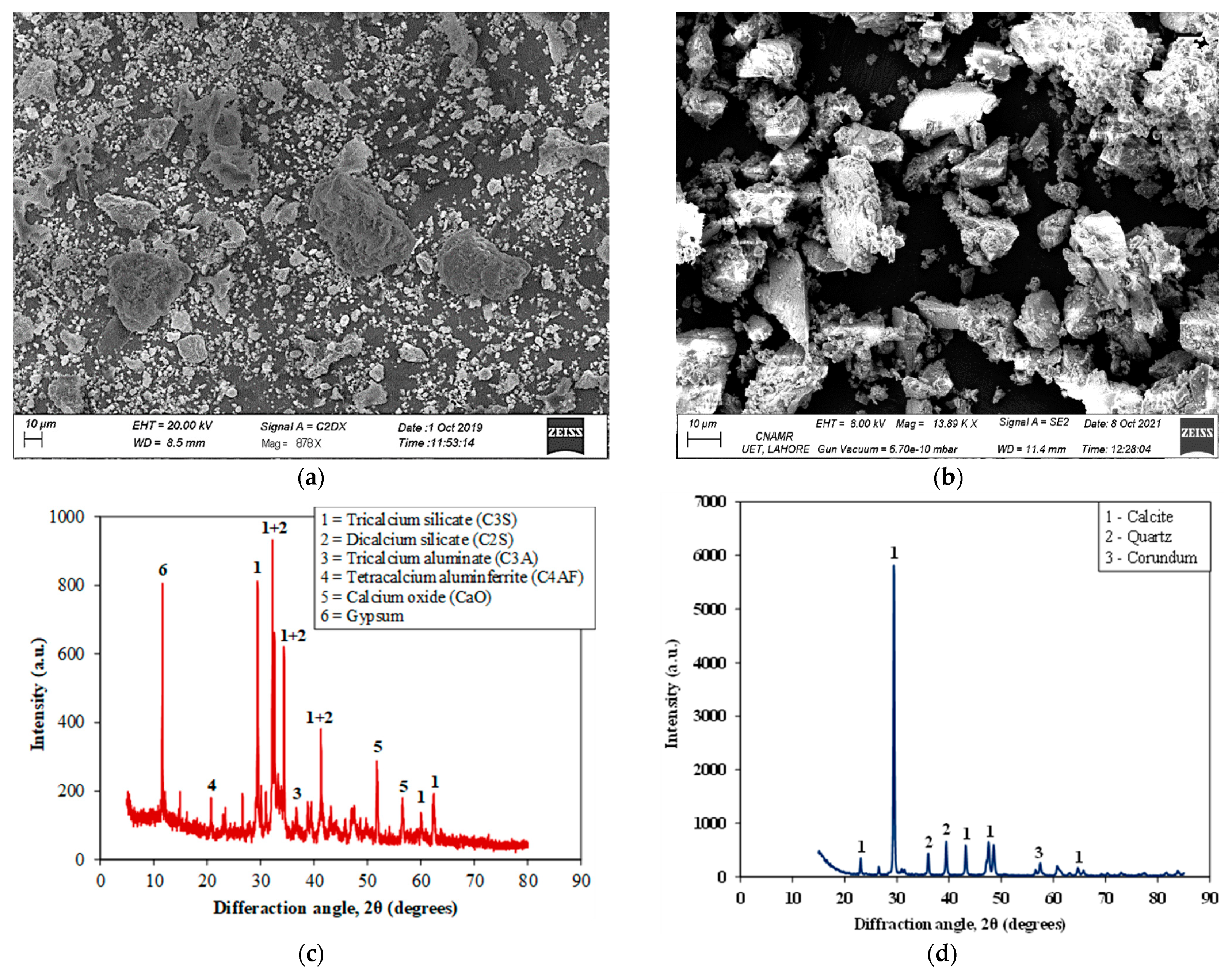
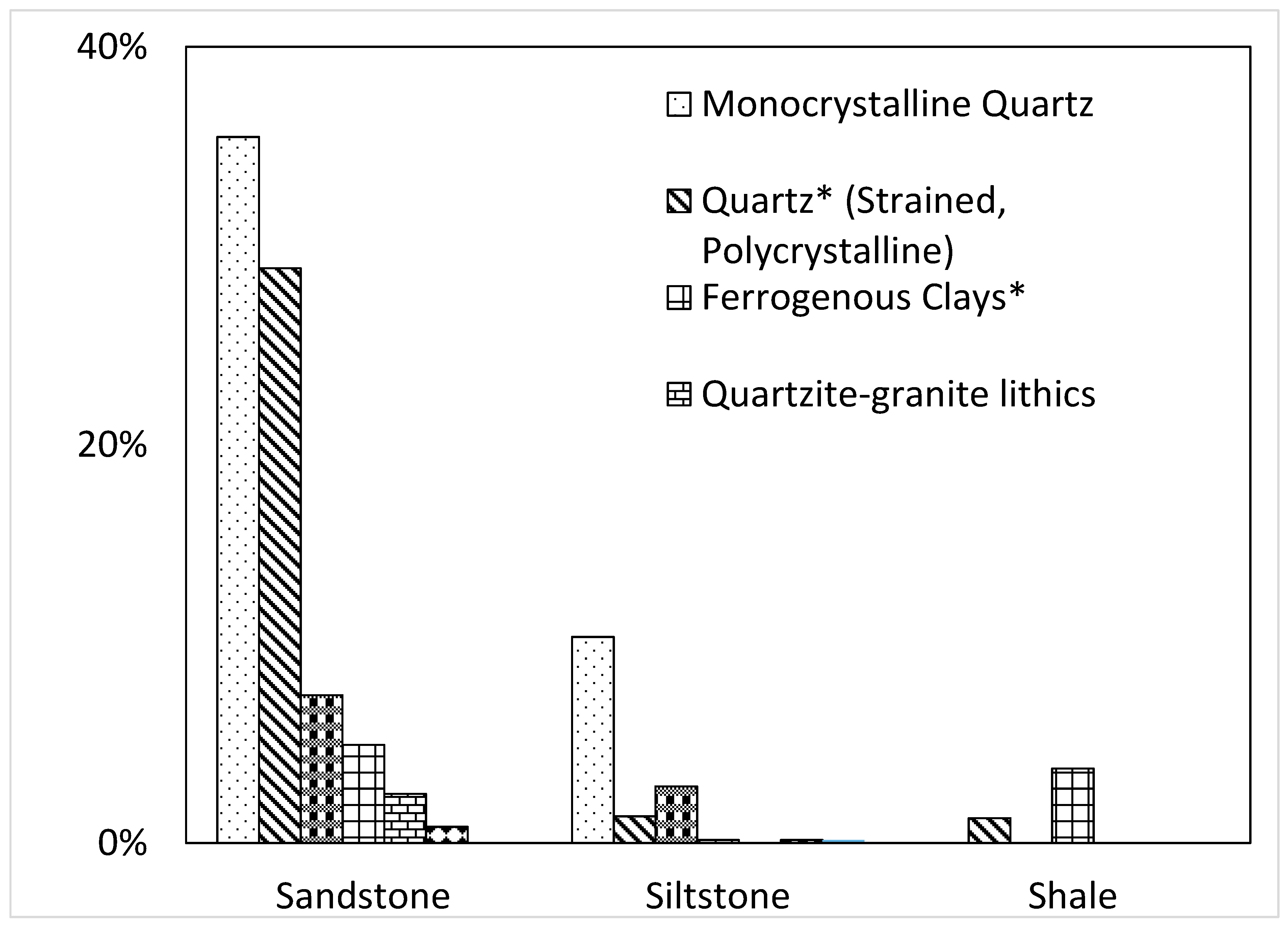

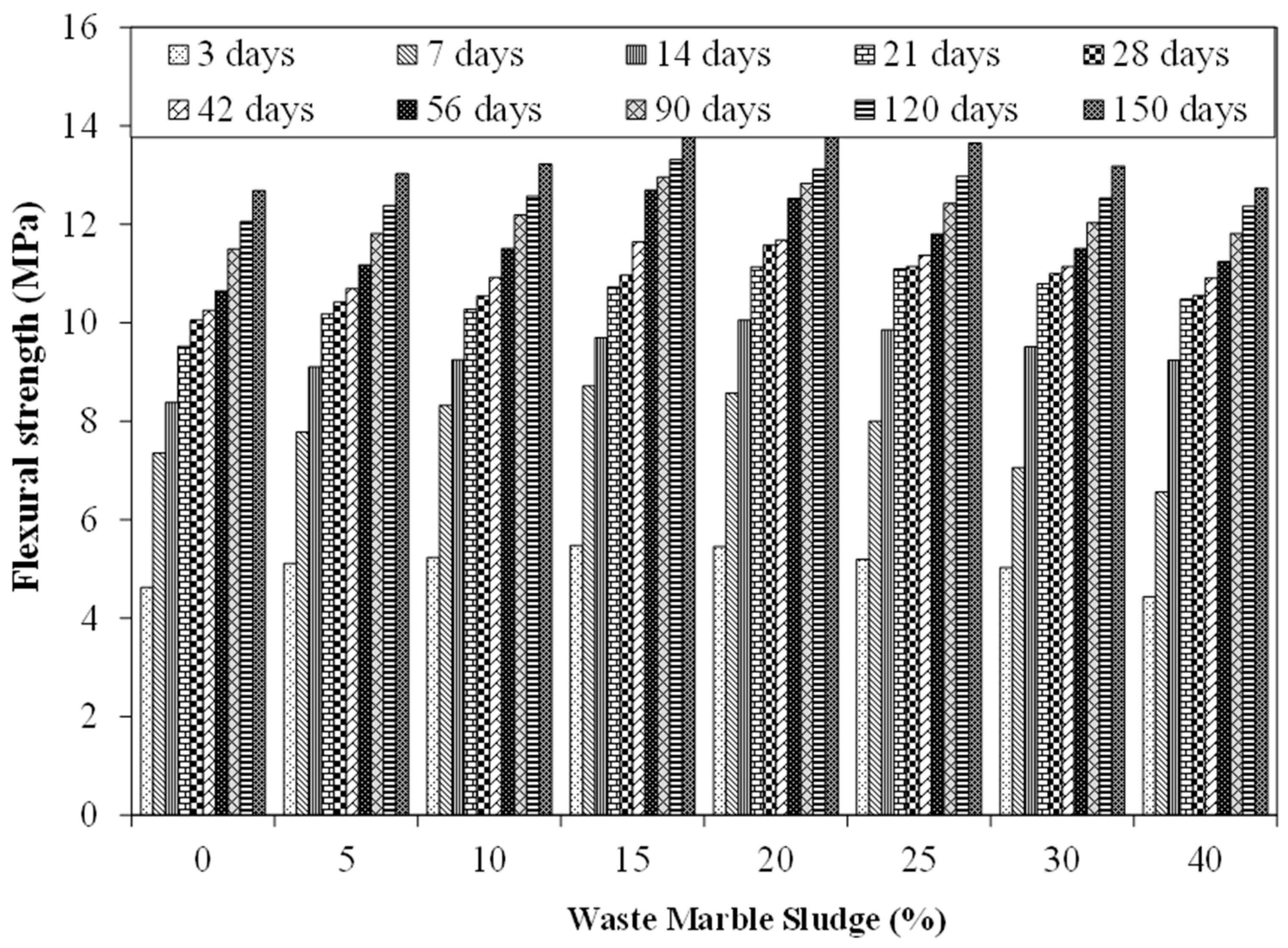
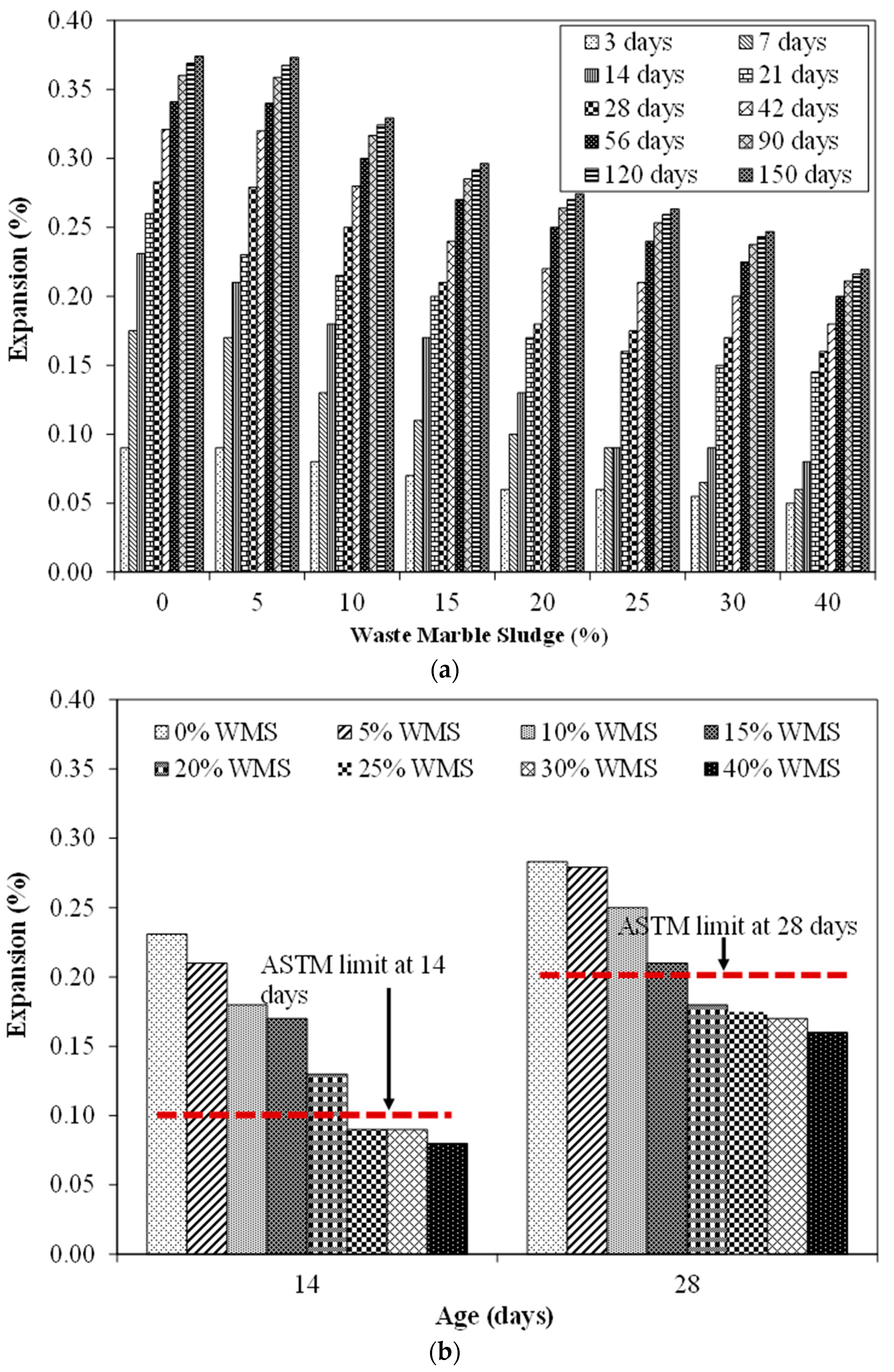
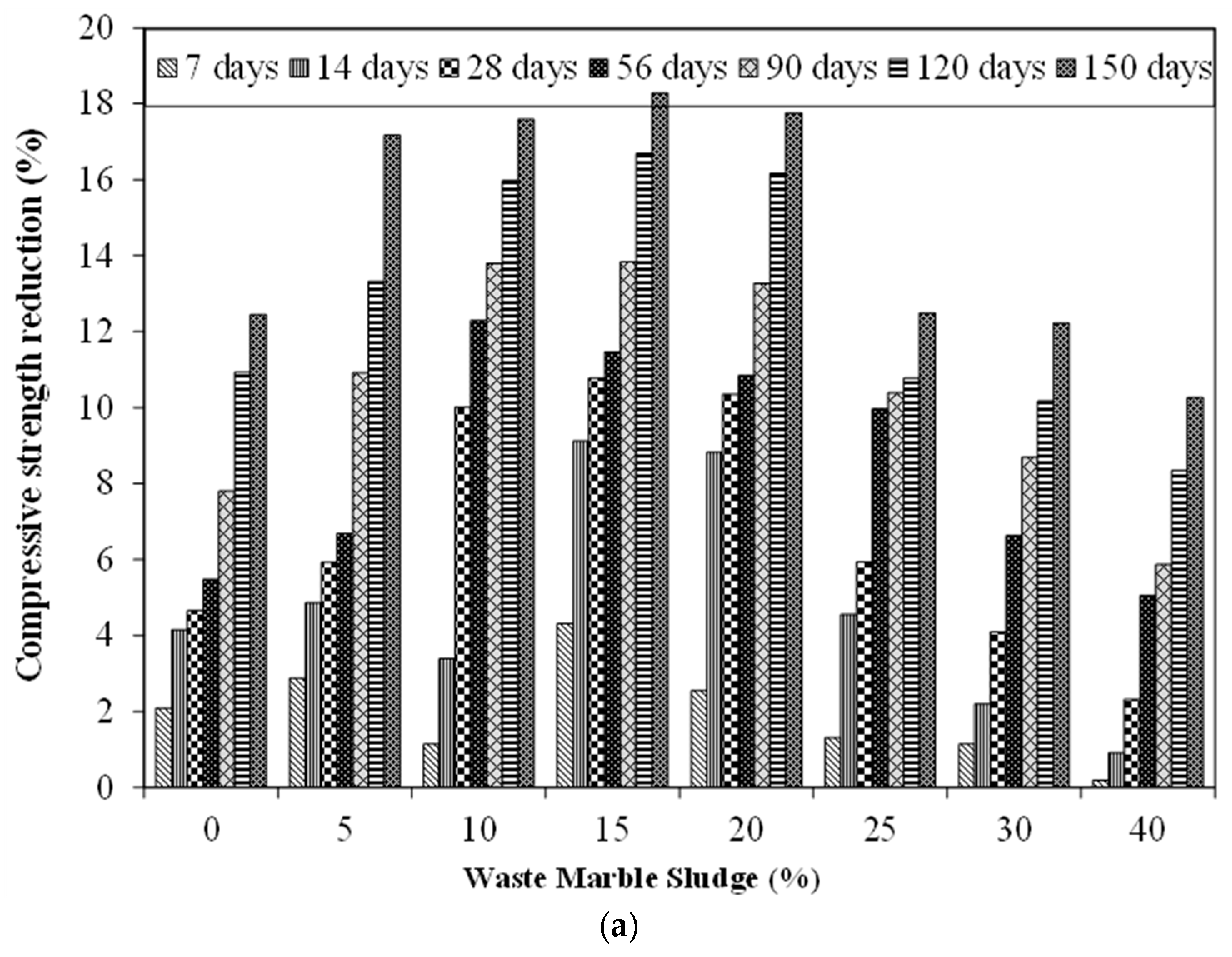

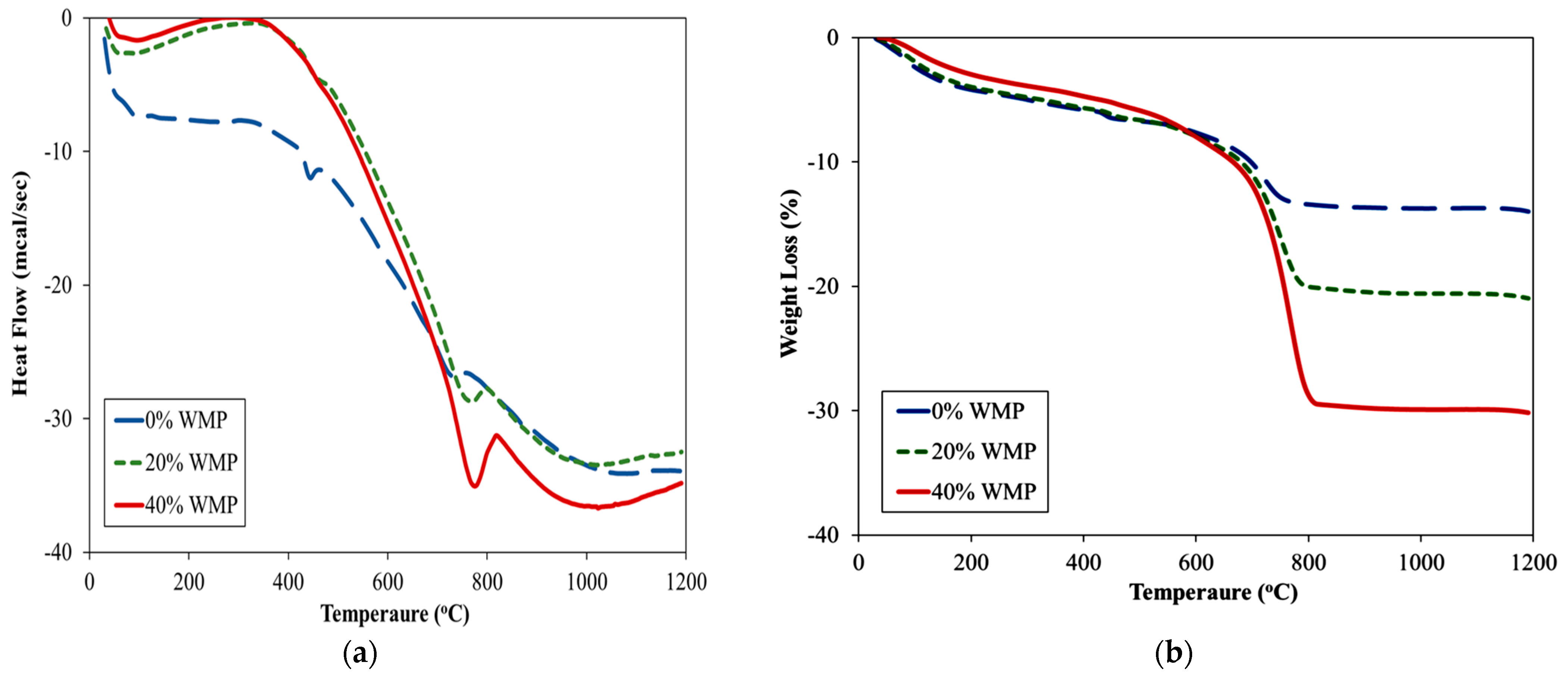
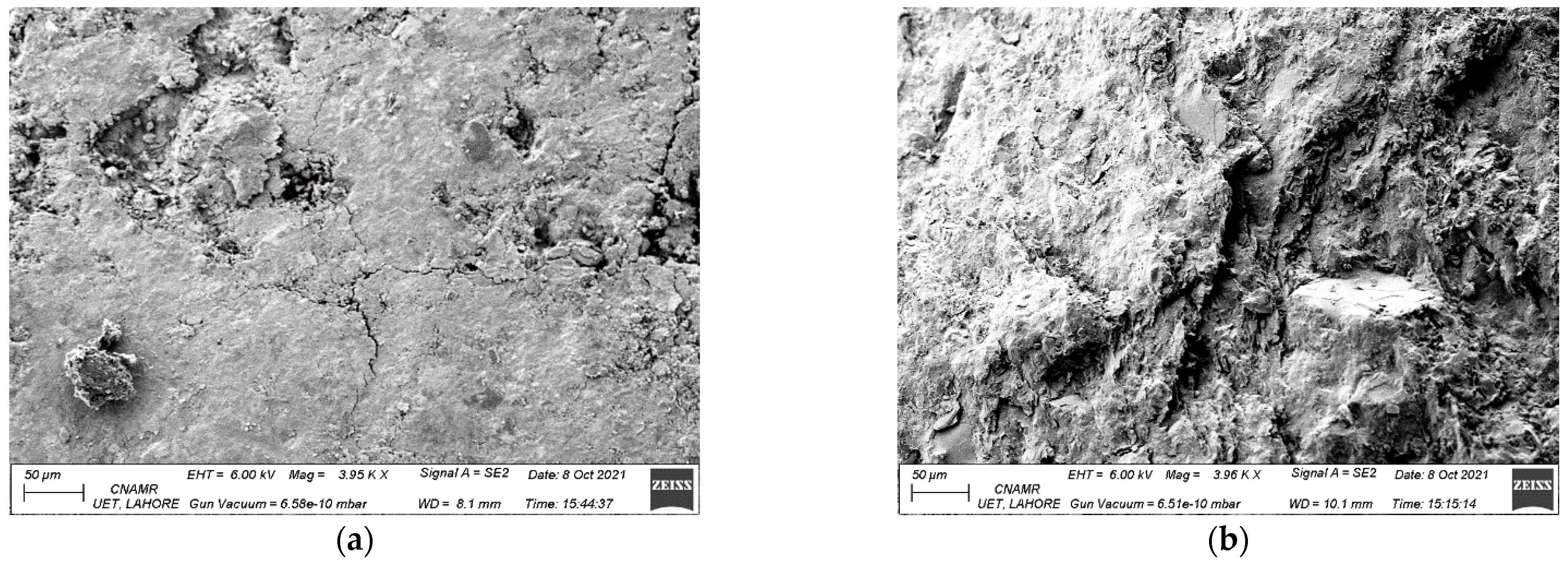
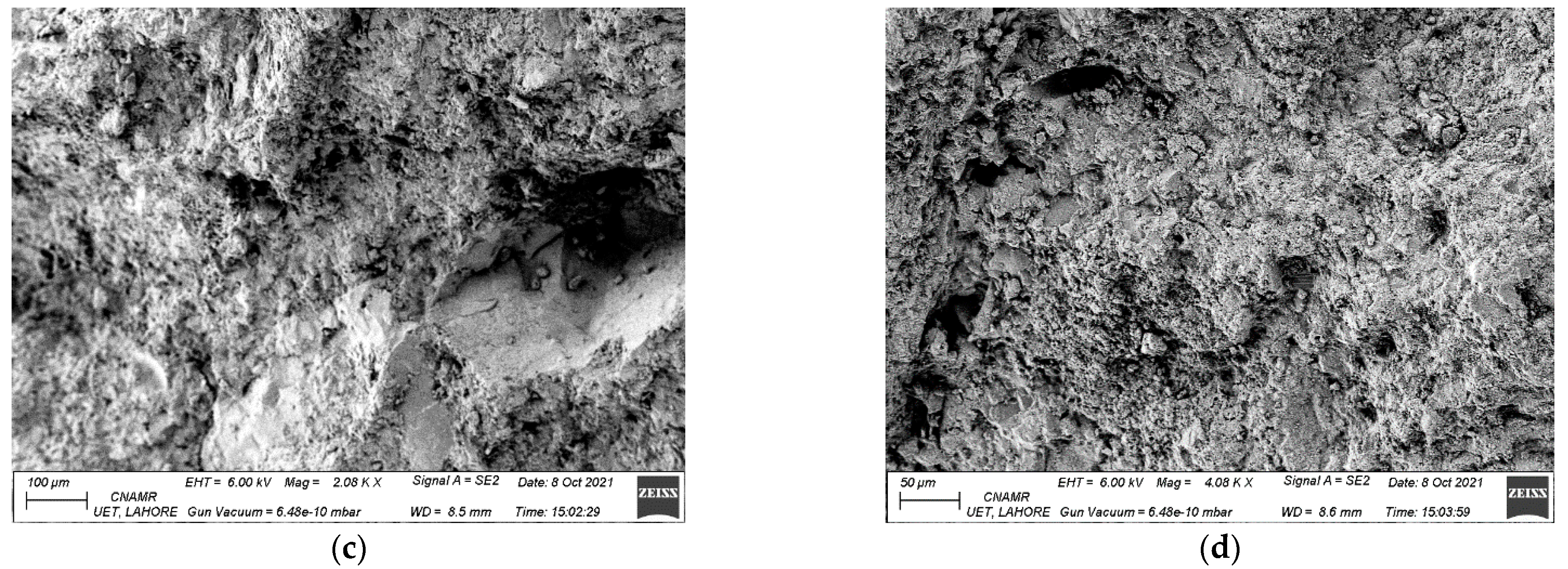
| Serial No. | Designation | Percentage Replacement by Aggregate |
|---|---|---|
| 1 | Control | - |
| 2 | MS5 | 5 |
| 3 | MS10 | 10 |
| 4 | MS15 | 15 |
| 5 | MS20 | 20 |
| 6 | MS25 | 25 |
| 7 | MS30 | 30 |
| 8 | MS40 | 40 |
| Constituents (%) | Cement | ASTM Limits (Cement) | MS |
|---|---|---|---|
| SiO2 | 20.85 | 17–25 | 1.03 |
| Al2O3 | 2.49 | 3–8 | 0.93 |
| Fe2O3 | 3.21 | 0.5–6.0 | 0.07 |
| CaO | 62.08 | 60–67 | 54.4 |
| MgO | 1.96 | 0.5–4.0 | 0.55 |
| SO3 | 3.48 | 2.0–3.5 | - |
| Na2O | 0.10 | - | 0.07 |
| K2O | 0.74 | - | 0.10 |
| Na2Oe | 0.58 | <0.6 | 0.13 |
| LOI | 2.78 | <3.0 | 42.98 |
| IR | 0.43 | <0.75 | - |
| C3S | 71.58 | 42–67 | - |
| C2S | 2.23 | 8–31 | - |
| C3A | 8.4 | 5–14 | - |
| C4AF | 9.66 | 6–12 | - |
| LSF | 1.00 | 0.66–1.02 | - |
| SR | 2.27 | 2.0–2.5 | - |
| AR | 1.64 | 1.5–2.5 | - |
| Properties | Cement | ASTM Limits (Cement) | MS | Standards |
|---|---|---|---|---|
| Specific gravity | 3.15 | 3.10–3.25 | 2.64 | ASTM C188 |
| Unit weight (kg/m3) | 1400 | 830–1650 | 1206 | ASTM C29 |
| Fineness (Passing 200 sieve) (%) | 90 | >90 | 100 | ASTM C204 |
| Blaine fineness (cm2/g) | 2200 | 2250 | 2237 | ASTM C184 |
| Autoclave expansion (%) | 0.13 | 0.20 | - | ASTM C151 |
| Standard consistency (%) | 24.6 | - | - | ASTM C187 |
| Initial setting time (Min) | 120 | >45 | - | ASTM C191 |
| Final setting time (Min) | 230 | <375 | - | ASTM C191 |
| Tests/Description | Results (%) |
|---|---|
| Chemical Properties | |
| Water-soluble chloride content (BS 812-117) | 0.043 |
| Sulfate content (BS 812-118) | 0.014 |
| Soundness by weighted average loss (Na2SO4), (ASTM C88) | 4.658 |
| Soundness by weighted average loss (MgSO4), (ASTM C88) | 5.270 |
| Calcium oxide (CaO) | 9.890 |
| Magnesium oxide (MgO) | 10.320 |
| Loss on ignition (LOI) | 15.400 |
| Silica (SiO2) | 56.920 |
| Alkali metals | 0.379 |
| Ferric oxide (Fe2O3) | 1.767 |
| Chromium oxide | 0.038 |
| Alumina (Al2O3) | 5.233 |
| Physical Properties | |
| Bulk Density (kg/m3) (ASTM C29) | 1307.42 |
| Specific Gravity (ASTM C188) | 2.6 |
| Water Absorption (%) | 2.2 |
| Impact Value (%) (BS 812) | 22.31% |
| Abrasion Test (%) (ASTM C535) | 22.30% |
Publisher’s Note: MDPI stays neutral with regard to jurisdictional claims in published maps and institutional affiliations. |
© 2022 by the authors. Licensee MDPI, Basel, Switzerland. This article is an open access article distributed under the terms and conditions of the Creative Commons Attribution (CC BY) license (https://creativecommons.org/licenses/by/4.0/).
Share and Cite
Ahmed, A.; Abbas, S.; Abbass, W.; Waheed, A.; Razzaq, A.; Ali, E.; Deifalla, A.F. Potential of Waste Marble Sludge for Repressing Alkali-Silica Reaction in Concrete with Reactive Aggregates. Materials 2022, 15, 3962. https://doi.org/10.3390/ma15113962
Ahmed A, Abbas S, Abbass W, Waheed A, Razzaq A, Ali E, Deifalla AF. Potential of Waste Marble Sludge for Repressing Alkali-Silica Reaction in Concrete with Reactive Aggregates. Materials. 2022; 15(11):3962. https://doi.org/10.3390/ma15113962
Chicago/Turabian StyleAhmed, Ali, Safeer Abbas, Wasim Abbass, Ayesha Waheed, Afia Razzaq, Elimam Ali, and Ahmed Farouk Deifalla. 2022. "Potential of Waste Marble Sludge for Repressing Alkali-Silica Reaction in Concrete with Reactive Aggregates" Materials 15, no. 11: 3962. https://doi.org/10.3390/ma15113962
APA StyleAhmed, A., Abbas, S., Abbass, W., Waheed, A., Razzaq, A., Ali, E., & Deifalla, A. F. (2022). Potential of Waste Marble Sludge for Repressing Alkali-Silica Reaction in Concrete with Reactive Aggregates. Materials, 15(11), 3962. https://doi.org/10.3390/ma15113962







